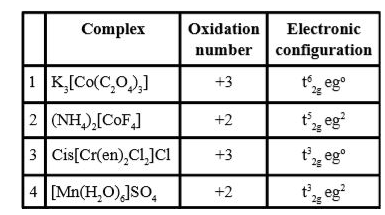Which of the following shell from an octahedral complex
(low spin)
(high spin)
(low spin)
None of these .
The correct Answer is:C
To determine which of the given electron configurations can form an octahedral complex, we need to analyze each option based on the principles of coordination chemistry and crystal field theory.
1. Understanding Octahedral Complexes:
- Octahedral complexes are formed when a central metal ion is surrounded by six ligands at the corners of an octahedron.
- The d-orbitals split into two sets in an octahedral field: the lower-energy t2g orbitals and the higher-energy eg orbitals.
2. Identifying the Electron Configurations:
- The options given are:
- d4 low spin
- d8 high spin
- d6 low spin
- none of these
3. Analyzing Each Configuration:
- d4 Low Spin:
- In a low-spin state, the electrons will fill the lower energy t2g orbitals first. For d4 low spin, the configuration would be t2g^4 eg^0. This is possible in an octahedral field with strong field ligands.
- d8 High Spin:
- In a high-spin state, the electrons will occupy the eg orbitals as well. For d8 high spin, the configuration would be t2g^6 eg^2. This is also possible in an octahedral field but typically occurs with weak field ligands.
- d6 Low Spin:
- For d6 low spin, the configuration would be t2g^6 eg^0. This is a common configuration for octahedral complexes, especially with strong field ligands.
- None of These:
- This option implies that none of the above configurations can form an octahedral complex, which is incorrect based on the analysis.
4. Conclusion:
- Among the options, d6 low spin is the most stable and common configuration that can form an octahedral complex. Therefore, the correct answer is d6 low spin.
Final Answer:
The shell that forms an octahedral complex is d6 low spin.
- Octahedral complexes are formed when a central metal ion is surrounded by six ligands at the corners of an octahedron.
- The d-orbitals split into two sets in an octahedral field: the lower-energy t2g orbitals and the higher-energy eg orbitals.
- The options given are:
- d4 low spin
- d8 high spin
- d6 low spin
- none of these
- d4 Low Spin:
- In a low-spin state, the electrons will fill the lower energy t2g orbitals first. For d4 low spin, the configuration would be t2g^4 eg^0. This is possible in an octahedral field with strong field ligands.
- d8 High Spin:
- In a high-spin state, the electrons will occupy the eg orbitals as well. For d8 high spin, the configuration would be t2g^6 eg^2. This is also possible in an octahedral field but typically occurs with weak field ligands.
- d6 Low Spin:
- For d6 low spin, the configuration would be t2g^6 eg^0. This is a common configuration for octahedral complexes, especially with strong field ligands.
- None of These:
- This option implies that none of the above configurations can form an octahedral complex, which is incorrect based on the analysis.
- Among the options, d6 low spin is the most stable and common configuration that can form an octahedral complex. Therefore, the correct answer is d6 low spin.
The shell that forms an octahedral complex is d6 low spin.
Topper's Solved these Questions
- COORDINATION COMPOUNDS BOOK - NCERT FINGERTPS ENGLISHCHAPTER - COORDINATION COMPOUNDS EXERCISE - HOTS
8 Videos
- COORDINATION COMPOUNDS BOOK - NCERT FINGERTPS ENGLISHCHAPTER - COORDINATION COMPOUNDS EXERCISE - NCERT EXEMPLAR PROBLEMS
14 Videos
- CHEMISTRY IN EVERYDAY LIFE BOOK - NCERT FINGERTPS ENGLISHCHAPTER - CHEMISTRY IN EVERYDAY LIFE EXERCISE - NCERT Exemplar
15 Videos
- ELECTROCHEMISTRYBOOK - NCERT FINGERTPS ENGLISHCHAPTER - ELECTROCHEMISTRYEXERCISE - Assertion And Reason
15 Videos
Similar Questions
Atomic number of Mn. Fe and Co are 25, 26 and 27 respectively. Which of the following inner orbital octahedral complex ions are diamagnetic ?
View SolutionAtomic number of Mn,Fe,Co and Ni are 25, 26, 27 and 28 respectively. Which of the following outer orbital octahedral complexes have same number of unpaired electrons ?
View Solution
Knowledge Check
Which of the following does not show octahedral geometry ?
ASF6BIF5CSiF2−6DSF4
Which of the following represent octahedral void ?
View SolutionWhich of the following octahedral complexes do not show geometrical isomerism ?
View SolutionWhich of the following octahedral complex does not show geometrical isomerism (A and B are monodentate ligands) ?
View SolutionWhich of the following octahedral complex does not show geometrical isomerism (A and B are monodentate ligands) ?
View SolutionWhich of the following is not organometallic complex ?
View SolutionWhich of the following is incorrectly matched complex?

View SolutionIn which of the following octahedral complexes of Co (at. no. 27), will the magnitude of Δo be the highest?
View Solution
